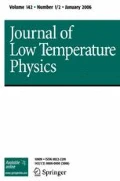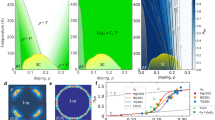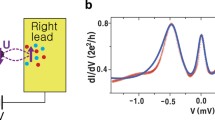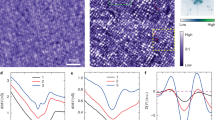Abstract
Quasiparticle tunneling spectra of both hole-doped (p-type) and electron-doped (n-type) cuprates are studied using a low-temperature scanning tunneling microscope. The results reveal that neither the pairing symmetry nor the pseudogap phenomenon is universal among all cuprates, and that the response of n-type cuprates to quantum impurities is drastically different from that of the p-type cuprates. The only ubiquitous features among all cuprates appear to be the strong electronic correlation and the nearest-neighbor antiferromagnetic Cu2+-Cu2+ coupling in the CuO2 planes.
Similar content being viewed by others
References
S. Sachdev, Science 288, 475(2000); and references therein.
M. Vojta, Y. Zhang, and S. Sachdev, Phys. Rev. B 62, 6721(2000).
D.-H. Lee, Phys. Rev. Lett. 88, 227003(2002).
N.-C. Yeh et al., Phys. Rev. Lett. 87, 087003(2001).
N.-C. Yeh et al., Physica C 364–365, 450(2001).
N.-C. Yeh et al., Physica C 367, 174(2002).
C.-T. Chen et al., Phys. Rev. Lett. 88, 227002(2002).
D. J. van Harlingen, Rev. Mod. Phys. 67, 515(1995).
C.-C. Tsuei and J. Kirtley, Rev. Mod. Phys. 72, 969(2000).
D. Pines, Physica C 282–287, 273(1997).
T. Timusk and B. Statt, Rep. Prog. Phys. 62, 61(1999).
V. J. Emery and S. A. Kivelson, Nature 374, 434(1995).
G. Siebold et al., Phys. Rev. B 58, 13506(1998).
C. M. Varma, Phys. Rev. B 55, 14554(1997).
V. J. Emery, S. A. Kivelson, and O. Zachar, Phys. Rev. B 56, 6120(1997).
Y. J. Uemura et al., Phys. Rev. Lett. 62, 2317(1989).
S. Chakravarty et al., Phys. Rev. B 63, 094503(2001).
P. A. Lee and X. G. Wen, Phys. Rev. Lett. 78, 4111(1997).
J. Y. T. Wei et al., Physica B 284, 973(2000).
R. P. Vasquez et al., Appl. Phys. Lett. 53, 2692(1988).
R. P. Vasquez et al., J. Phys: Condens. Matter 13, 7977(2001).
J. Y. T. Wei et al., Phys. Rev. Lett. 81, 2542(1998).
I. Maggio-Aprile et al., J. Electr. Spectro. 109, 147(2000).
N. Miyakawa et al., Phys. Rev. Lett. 83, 1018(1999); N. Miyakawa et al., Phys. Rev. Lett.ibid. 80, 157(1998).
V. M. Krasnov et al., Phys. Rev. Lett. 84, 5860(2000).
K. M. Lang et al., Nature 415, 412(2002).
S. Misra et al., Phys. Rev. Lett. 89, (2002).
A. V. Balatsky, M. I. Salkola, and A. Rosengren, Phys. Rev. B 51, 15547(1995).
M. I. Salkola et al., Phys. Rev. Lett. 77, 1841(1996).
M. E. Flatte and J. M. Byers, Phys. Rev. B 56, 11213(1997).
M. I. Salkola, A. V. Balatsky, and J. R. Schrieffer, Phys. Rev. B 55, 12648(1997).
M. Vojta and R. Bulla, Phys. Rev. B 65, 014511(2001).
H. Alloul et al., Phys. Rev. Lett. 67, 3140(1991).
K. Ishida et al., Phys. Rev. Lett. 76, 531(1996).
Y. Sidis et al., Phys. Rev. Lett. 84, 5900(2000).
P. W. Anderson, Phys. Rev. Lett. 3, 325(1959).
A. V. Chubukov and N. Gemelke, Phys. Rev. B 61, R6467(2000).
C.-L. Wu, C.-Y. Mou, and D. Chang, Phys. Rev. B 63, 172503(2001).
A. Lanzara et al., Nature 412, 510(2001).
J. X. Zhu, C. S. Ting, and C. R. Hu, Phys. Rev. B 62, 6027(2000).
S. H. Pan et al., Nature 403, 746(2000).
L. Alff et al., Phys. Rev. Lett. 83, 2644(1999).
C.-C. Tsuei and J. Kirtley, Phys. Rev. Lett. 72, 969(2000).
J. A. Skinta et al., Phys. Rev. Lett. 88, 207005(2002).
A. A. Abrikosov and L. P. Gor'kov, Soviet Phys. JETP 12, 1243(1961).
C. U. Jung et al., Physica C 366, 299(2002).
H. Shiba, Prog. Theor. Phys. 40, 435(1968).
L. Alff, private communications.
C. U. Jung et al., Phys. Rev. B 65, 172501(2002).
E. W. Hudson et al., Nature 411, 922(2001).
Author information
Authors and Affiliations
Rights and permissions
About this article
Cite this article
Yeh, NC., Chen, CT., Vasquez, R.P. et al. Scanning Tunneling Spectroscopic Studies of the Pairing State of Cuprate Superconductors. Journal of Low Temperature Physics 131, 435–444 (2003). https://doi.org/10.1023/A:1022934832360
Issue Date:
DOI: https://doi.org/10.1023/A:1022934832360




